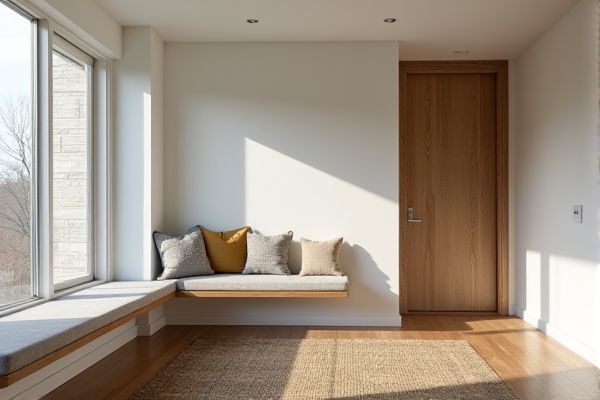
A floating bench offers a modern, space-saving design by appearing to hover off the ground, creating an open and airy feel, while a built-in bench provides sturdy, permanent seating that maximizes space utilization with integrated storage options. Discover key differences and decide which bench style best suits your home's aesthetic and functional needs by reading the rest of the article.
Table of Comparison
| Feature | Floating Bench | Built-in Bench |
|---|---|---|
| Installation | Wall-mounted, no floor support needed | Fixed to floor and/or walls, permanent |
| Space Efficiency | Creates open floor space, illusion of larger room | Maximizes seating, can include storage underneath |
| Design Flexibility | Modern, minimalist style | Customizable shapes and materials |
| Weight Capacity | Moderate, depends on wall strength | High, supports more weight reliably |
| Maintenance | Easier to clean underneath | More difficult to clean around |
| Cost | Generally lower, easier installation | Higher, custom construction needed |
Introduction: Floating Bench vs Built-In Bench
Floating benches offer a modern, minimalist design by being mounted to the wall without visible supports, creating an airy feel and maximizing floor space. Built-in benches provide sturdy, permanent seating integrated into the structure, often featuring additional storage options and a custom fit to the room's dimensions. Both options enhance interior functionality, but floating benches excel in contemporary aesthetics while built-in benches prioritize durability and practicality.
Definition and Key Features
A floating bench is a seating fixture mounted to the wall, creating a sleek, modern look with open space beneath, which enhances room airiness and ease of cleaning. In contrast, a built-in bench is integrated into the structure, often featuring storage compartments and a more solid, permanent presence that maximizes space efficiency. Key features of floating benches include minimalistic design and ease of installation, while built-in benches are prized for durability and added functionality such as hidden storage.
Design Aesthetics and Visual Impact
Floating benches create a sleek, modern design with a minimalist aesthetic by appearing to hover off the floor, enhancing a sense of spaciousness and lightness in the room. Built-in benches offer a cohesive and integrated look, blending seamlessly with walls or surrounding cabinetry to provide a sturdy, permanent fixture that anchors the space visually. The choice between floating and built-in benches significantly influences spatial perception, with floating benches promoting openness and built-in benches contributing to structural solidity and architectural detail.
Space Utilization and Flexibility
Floating benches maximize space utilization by freeing up floor area beneath, creating an open and airy environment ideal for small or multifunctional rooms. Built-in benches offer fixed seating with integrated storage, optimizing compact spaces by combining functionality and permanence. Choosing between them depends on desired flexibility; floating benches allow easy rearrangement, while built-in benches provide durable, custom-fit solutions.
Installation Process and Complexity
Floating benches require a more complex installation process, often involving secure wall anchors and precise measurements to ensure stability without visible support underneath. Built-in benches typically involve integrating the bench directly into existing structures, such as walls or cabinetry, which may demand carpentry skills but generally allows for easier attachment and a solid foundation. Both options need accurate planning, but floating benches present a higher challenge due to weight distribution and wall strength considerations.
Durability and Maintenance
Floating benches are typically constructed with wall-mounted brackets that may limit weight capacity and require periodic checks for secure attachment, while built-in benches offer superior stability due to their integration with existing structures. Materials used in built-in benches, such as solid wood or masonry, tend to provide enhanced durability and better resistance to wear and tear compared to many floating bench designs. Maintenance for built-in benches is generally lower because they are less prone to structural issues and often feature finishes that withstand frequent use and environmental exposure.
Cost Comparison
Floating benches typically cost more than built-in benches due to their need for specialized mounting hardware and design considerations to ensure stability and aesthetics. Built-in benches, often constructed from standard cabinetry or woodworking materials, tend to have lower material and labor expenses, making them a more budget-friendly option for many homeowners. For projects prioritizing cost-efficiency, built-in benches provide a functional seating solution without the premium pricing associated with floating bench installation.
Customization Options
Floating benches offer greater customization options with adjustable heights, modular components, and the flexibility to incorporate storage or lighting features tailored to personal preferences. Built-in benches provide customization through integration with architectural elements, allowing seamless alignment with room dimensions and materials for a cohesive design. Both styles enable personalization, but floating benches excel in adaptable configurations suited for evolving needs.
Ideal Applications and Best Uses
Floating benches are ideal for modern, minimalist interiors where a clean, open floor space enhances visual flow and room perception, making them perfect for small apartments or contemporary offices. Built-in benches excel in maximizing seating and storage in kitchens, mudrooms, and dining nooks, seamlessly integrating with cabinetry and walls to provide a durable, space-saving solution. Both options cater to different spatial needs, with floating benches emphasizing aesthetics and built-in benches prioritizing functionality and permanence.
Conclusion: Which Bench is Right for You?
Choosing between a floating bench and a built-in bench depends on your space, style preferences, and functionality needs. Floating benches offer a modern, minimalist look that maximizes floor space and enhances room openness, while built-in benches provide sturdy, integrated seating with added storage opportunities. Consider your room size and how you plan to use the bench to determine which option aligns best with your lifestyle and design goals.
 homyna.com
homyna.com